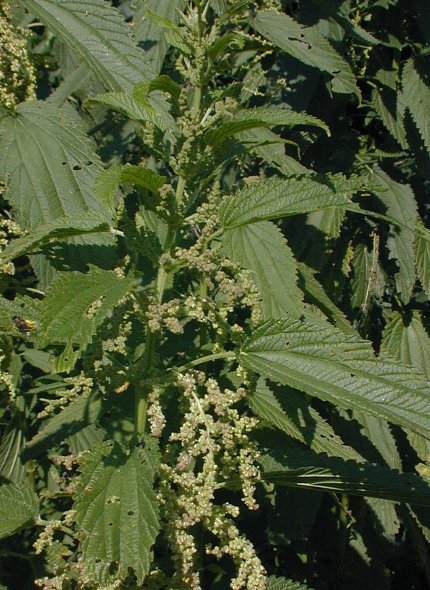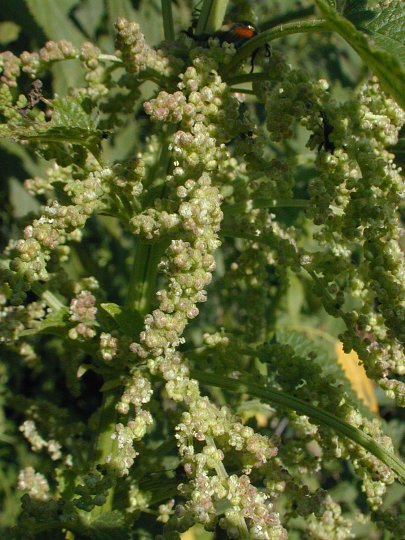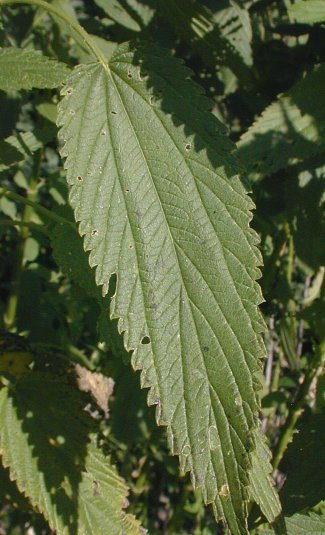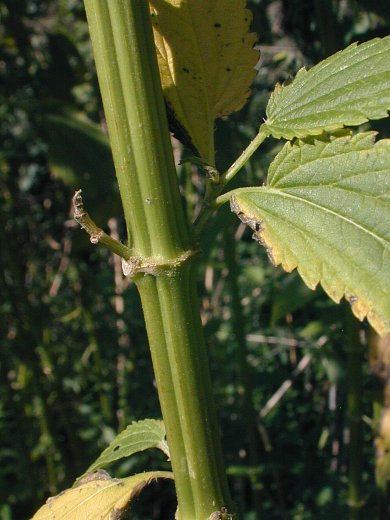Description: This perennial plant is 3-7' tall and usually unbranched, although short stems may develop from the leaf axils. The central stem is light green and stout; it has several flat ridges that are separated by narrow channels. The central stem is sparsely covered with stiff white hairs of variable length; these hairs can penetrate the skin and sting. Along the central stem are pairs of opposite leaves that droop downward slightly. The leaf blades are up to 8" long and 2½" across; they are medium to dark green, lanceolate, and coarsely serrated. The base of each leaf blade is rounded or slightly cordate. The upper surface of each leaf blade is heavily veined and glabrous, while the lower surface has sparse stiff hairs that can also sting. The slender petioles of the leaves are up to 1" long. At the base of each petiole, there is a pair of stipules up to ½" long.

Panicles of flowers develop from the axils of the middle to upper leaves. These panicles are much branched and droop downward; their pubescent branches are heavily covered with flowers. Slender Nettle is monoecious to slightly dioecious; some plants have male flowers entirely or predominantly, while other plants have female flowers entirely or predominately. The male flowers are 1/8" (3 mm.) across with 4 green sepals and 4 white stamens. The female flowers are 1/8" across with 4 green sepals; the 2 inner sepals that enclose the ovary are larger in size than the 2 outer sepals. The sepals of both male and female flowers are pubescent; neither kind of flower has petals. The blooming period occurs during the summer and can last 1-2 months for a colony of plants. Pollination of the flowers is by wind. The brown seeds are 1.0–1.5 mm. long and irregular in shape. They can remain viable in the ground for 10 years. The root system is fibrous and rhizomatous. Clonal colonies are often produced from the long rhizomes.

Cultivation:
The preference is partial sun to light shade, moist to mesic
conditions, and a fertile loamy soil. Most growth occurs during late
spring and mid-summer. This plant can spread aggressively in favorable
situations. The leaves are often attacked by insects.
Range & Habitat:
The native Slender Nettle is occasional to locally common in central
and northern
Illinois, while in the southern section of the state it is uncommon or
absent (see Distribution
Map). Habitats include disturbed open woodlands, floodplain
woodlands, woodland
borders, thickets, meadows in wooded areas, partially shaded seeps,
fence rows, and moist waste areas. Areas with a history of disturbance
are preferred.

Faunal
Associations:
Caterpillars of the butterflies Vanessa atalanta
(Red Admiral), Nymphalis milberti (Milbert's
Tortoiseshell), Polygonia comma (Comma), and Polygonia
interrogationis (Question Mark) feed on the foliage of Urtica
spp. (nettles). Other insects that feed on nettles
include leaf-mining larvae of the beetle Sumitrosis inaequalis,
stem-boring larvae of the lizard beetle Acropteroxys gracilis,
leaf-mining larvae of the midge Agromyza
subnigripes, larvae of Dasineura urnicola
(Nettle Urn Gall Midge), larvae of the moth Glyphipterix quadragintapunctata,
and the leafhopper Empoasca
vergena. The presence of stinging hairs in nettles
provides some protection from the browsing of mammalian herbivores.
Because Slender Nettle is relatively tall and often forms clonal
colonies, it provides cover and protection for various insects,
mammals, and birds.
Photographic Location:
The edge of a woodland in Urbana, Illinois.

Comments: Slender Nettle is less heavily armed with stinging hairs than Urtica dioica (Stinging Nettle) and Laportea canadensis (Wood Nettle). Sometimes Slender Nettle is regarded as a variety of Stinging Nettle, in which case it is referred to as Urtica dioica gracilis. Stinging Nettle is adventive from Eurasia and has rarely naturalized in Illinois. It is shorter in stature and has wider leaves than Slender Nettle. The native Wood Nettle is similar in appearance to Stinging Nettle, except that it has alternate leaves. Unfortunately, these 3 species are often confused with each other. While many people dislike Urtica spp. (Nettles) and similar species because of their stinging hairs, they are important food plants to several species of butterflies. The young leaves of Nettles are edible if they are boiled in water and transformed into a creamy soup; they are supposed to be an excellent source of several vitamins and minerals.